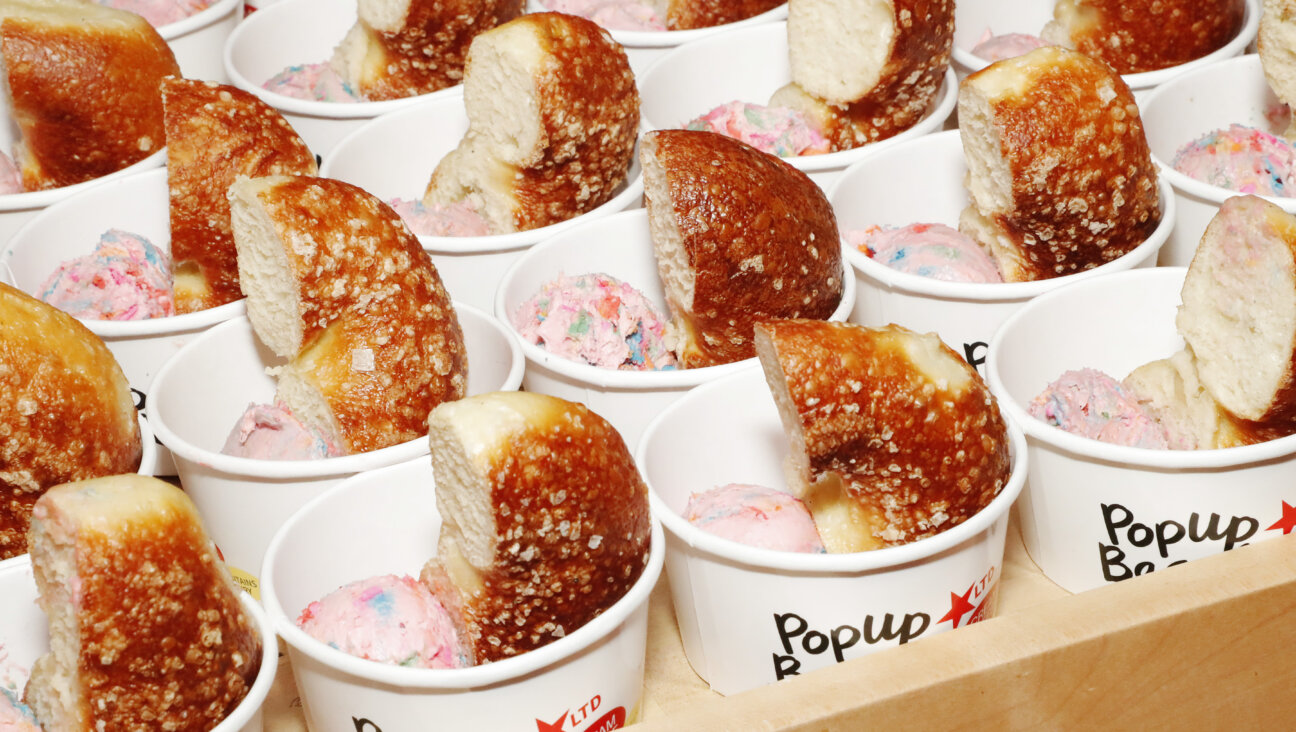In isolation, I made ‘terroir breads’ from the land

Terroir bread Image by Erez Komarovsky
The Forward welcomes Erez Komarovsky as its newest contributing writer. Read more about Erez here.
For the past two-and-a-half months, we have been quarantined in my hillside home in Mattat, in the north of Israel, just a few kilometers from the Lebanon border.
We are isolated from the world, like everyone else– no cooking workshops here in my home, no travel to Tel Aviv to do events, no television show. Just cooking and baking every moment of every day for myself and my partner.
And you know what? This period has truly revolutionized baking for me.
These initial quarantine months fell over the end of winter and through spring, so I got to tend to the garden every day, to weed and cultivate the land. To replace winter beds with summer beds. To plant, sprout and sow.
I baked and cooked with all the things that dramatically changed within the garden from week to week. Za’atar season came and went, artichoke season started and finished, the green garlic sprouted and was picked. The green broad beans and peas replaced themselves with cucumbers and tomatoes. The cabbage was all gone and so was the spinach. Watercress bloomed and wilted, the cilantro grew and bloomed.

Terroir bread with artichoke leaves Image by Erez Komarovsky
During this end of the winter and spring period, there has been a lot of rainfall in Israel, especially here in the mountains. We were blessed with the craziest spring bloom –– the harder it’s been for us humans, the happier nature became.
And so I found myself foraging mustard flowers, Judas tree flowers and cherry blossoms, picking roses and foraging wild artichokes and other wild plants.
I saw the wheat terraces I sowed sprouting and maturing. It was mallow season, along with Jerusalem sage and yellow wood sorrel. All day long I wandered in the oak forest enveloping the house, looking for anything I could add to the pots and bread.

Fields of wheat go directly into the bread Image by Erez Komarovsky
And so it happened that I ended up with breads that are most connected to the season and my place. Foraging breads, I call them, or terroir bread, because they are truly from the earth around my house.
I’ve had olives, eggplants and tomatoes in my breads before, but, suddenly, I was no longer ashamed to decorate the bread with spring flowers and weave into the challah garlic flowers and pink roses.
The process was the most important thing. The beauty of the bread loaves rising, with all these flowers from the forest and orchard, was no less important to me than the end result. And despite the leaves and flowers turning almost completely brown coming out of the oven, it didn’t bother me at all.

Terroir bread with mallow Image by Erez Komarovsky
As a matter of fact, I saw their true beauty during the rising process. On the other hand, their taste had become bold and wild. The mallow leaves and wild arum I foraged turned into a crazy bread. The rose challah was gentle and fragrant.
Just like in my cooking, I started using all the vegetables in a way that echoed the “nose to tail” idea, from the roots to the blossom.
Sunflower seed challah with sunflower leaves and a dry sunflower in its center gave me a new perspective into the flavor profile of the sunflower. There was fougasse with the garden’s artichokes wrapped around the stems of the foraged wild artichokes, garlic bread with whole green garlic and wild garlic flowers, mustard flower buns for hamburgers ––all these turned the breads truly wonderful.
And thus I stopped being afraid to add more and more things to my dough and slowly, slowly, bake by bake, I “came out” of the baking snobbism “closet.” Good bread is nothing but flour, water, salt and leaven? Think again. As it turns out, it’s not just the size of the holes in the bread dough that matter.
I am happy to share with you this process I have gone through, and I hope you enjoy the baking.
Sunflower Challah

Sunflower challah Image by Erez Komarovsky
1 kg. challah flour
40 gr. fresh yeast
500 gr water
1 egg + 1 egg yolk
170 gr. unrefined cold-pressed sunflower oil (comes from Russia and Ukraine and can be easily found in health stores).
60-70 gr Demerara sugar
250-300 gr sunflower seeds
25 gr salt
Knead the flour with the yeast, then add the rest of the ingredients except for the seeds and salt. Knead for 6-7 minutes until the dough looks smooth, then add the salt.
Knead a bit faster for 3 minutes. Add the sunflower seeds and knead for a further minute.
Leave to rise in a bowl oiled with the cold-pressed sunflower oil for 45 minutes. Fold the dough and leave to rise for another 45 minutes.
Divide the dough into 6 balls. Leave to rest for 20 minutes under plastic wrap. Roll each ball into sausage-shaped links.
Braid the challah haphazardly around a sunflower head and weave sunflower leaves into the braids. Lightly brush the top with egg diluted with a bit of water and fine-milled salt, and sprinkle more sunflower seeds over it all.
Bake for 30 mins in 360 F. Makes two loaves.
Wild Garlic Flower Pampushki

Wild Garlic Flower Pampushki Image by Erez Komarovsky
Pampushki are Ukrainian buns, traditionally eaten with beet borscht.
1 kg bread flour
350 gr water
300 gr 2% milk
40 gr fresh yeast
25 gr.sugar
150 gr of butter that’s been left out of the fridge for 30 minutes and cut into small cubes
13 gr. salt
Knead everything apart from the salt and butter until the dough is smooth and even. Add the salt and, on medium speed while kneading, add the butter cubes until they are absorbed evenly. Move to a buttered bowl.
Leave to rise for about an hour. Split into 24 balls. Leave to rise for a further 20 minutes. Knead all the balls once more and leave in a buttered baking tin to rise one nestled next to the other.
Brush with cream and sprinkle with finely milled salt.
Bake for 25-30 mins in a hot oven with steam (360F).
Meanwhile mash together 1 bunch of chopped fresh dill and 10 peeled, chopped garlic cloves, and mix with 100 gr of butter.
When the pampushkies are out of the oven, brush immediately with the dill, butter and garlic mixture.
You can also do what I did and weave whole green garlic and garlic flowers into the pampushki..
Mustard and Mustard Flower Burger Buns

Mustard and Mustard Flower Burger Buns Image by Erez Komarovsky
1kg bread flour
30 gr fresh yeast
500 gr of water
1 egg
160 gr. sunflower oil
36 gr. natural cane sugar
12 gr. salt
70 gr. Dijon mustard
12 gr. roughly ground black pepper
In a mixer with a dough hook or in a large bowl, ix the flour with the yeast. Add water, egg, sugar and mustard and mix.
Start kneading on low speed and add in the oil. Knead until the dough is smooth and even. Add the salt and pepper and continue kneading a bit more intensively for about 4 minutes. Leave to rest for 1 hour in an oiled bowl and cover with a non-stick plastic sheet (like a garbage bag). Divide into 16 balls. Lay on a sheet of baking paper with the seam facing down. Cover with the plastic bag and rest for 1 hour.
Press each ball lightly with your palm and leave to rise for a further 20 minutes. Brush with yolk mixed with a little water and mustard. Sprinkle unhulled sesame seeds over the top and bake for 18-20 minutes in 360 F.
If they are in season in your area, you can sprinkle a bunch of wild mustard flowers, well-washed and dried, over the top along with the sesame seeds.
A message from our Publisher & CEO Rachel Fishman Feddersen

I hope you appreciated this article. Before you go, I’d like to ask you to please support the Forward’s award-winning, nonprofit journalism during this critical time.
We’ve set a goal to raise $260,000 by December 31. That’s an ambitious goal, but one that will give us the resources we need to invest in the high quality news, opinion, analysis and cultural coverage that isn’t available anywhere else.
If you feel inspired to make an impact, now is the time to give something back. Join us as a member at your most generous level.
— Rachel Fishman Feddersen, Publisher and CEO
























